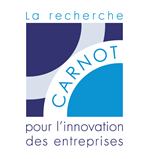Automotive and mobility
The automotive industry comprises original equipment manufacturers and automobile service companies. The original equipment sector is made up of manufacturers (OEMs) (of cars, two-wheeled vehicles, trucks, buses, etc.), Tier 1 parts manufacturers and suppliers, and mid-caps and SMEs working wholly or partly for the sector. The aftermarket consists of service companies (marketing and distribution, testing, maintenance, mobility solutions, etc.)(commerce et distribution, contrôle, maintenance, solution de mobilité).
Carnot Institutes strongly involved
Examples of partnerships with companies in the sector
INDUNOR provides the auto and construction sectors with natural foam, free from volatil organic compounds
Partnership ICÉEL Carnot Institute - INDUNORIndustrial firms want expandable or flexible foam insulation! These foams are made from synthetic resins and handling and using them involves proven health risks due to the presence of formaldehyde and other VOCs. By teaming up with Lermab (Carnot ICÉEL Institute), Indunor – a specialist in tannin production – has come up with alternative natural resins that can be used to make pollutant-free foam.
INDUNOR provides the auto and construction sectors with natural foam, free from volatil organic compounds
Industrial firms want expandable or flexible foam insulation! These foams are made from synthetic resins and handling and using them involves proven health risks due to the presence of formaldehyde and other VOCs. By teaming up with Lermab (Carnot ICÉEL Institute), Indunor – a specialist in tannin production – has come up with alternative natural resins that can be used to make pollutant-free foam.
Supporting Innovation
Studies performed since the 1980s into the harmfulness of formaldehyde and volatil organic compounds have led certain governments to limit or even prohibit their use. The hazards of exposing employees to chemical risks, as well as consumer protection requirements are forcing industrial companies to come up with new formulae for producing the foams that have become so essential in thermal and electrical insulation and soundproofing. Indunor's engineers wished to harness certain characteristics of tannins – and their extensive expertise in tannin extraction – to come up with a biosourced component that could replace petrochemical-based resins. This Argentine-based company has been working with tannins from the quebracho – a tree that is native to the Gran Chaco province in South America – and the chestnut tree. Thanks to research carried out by Lermab (ICÉEL Carnot Institute), these tannins can be used in resins suitable for producing foams adapted to different uses. They have remarkable strength, fire resistance and thermal insulation qualities and provide industrial firms with sustainable solutions. Indunor has set up a “Natural resins” division that rounds out its food and health products offering.
The client needs
INDUNOR, a Silvateam Group subsidiary, is a big player in tannin and vegetable extraction and commercialisation. It produces and markets food additives, stabilizers, thickeners and supplements on a global scale. While tannins have traditionally been used in leatherwork and winemaking, they have also been used to produce highly fire-resistant foams with great insulation properties since the 2000s. However, the mimosa it had previously been using was not sufficient to meet burgeoning demand and Indunor needed to find a viable long-term alternative. The quebracho tree contains condensed tannins (their structure is similar to flavonoids, i.e., they polymerize), and those of the chestnut are hydrolyzable (polyester carbohydrates and phenolic acids). To analyse these tannins, and turn them into a raw material capable of meeting the needs of industrial firms, Indunor teamed up with the Lermab laboratory, which boasts 20 years’ experience in the production of tannin-based foams.
Partnership
ICÉEL Carnot Institute, based in eastern France, works in the field of materials, processes, environment and energy. It combines 27 labs and technical centres, including Lermab, which specialises in research into wood, covering the molecular to the macroscopic level, and even wooden structures. A research partnership lasting several years, underpinned by a doctoral thesis, culminated in the filing of a number of patents on a co-ownership basis. Lermab, along with the Jean Lamour Institute, another part of ICÉEL in charge of the characterisation work, has enabled Indunor to market natural resins that represent real progress in solving a worldwide problem. The Silvateam Group is seeking to consolidate the leadership of its subsidiary, Indunor, in sustainably produced resins that help businesses comply with environmental guidelines. The enthusiasm of industrial companies for Indunor’s natural resins is a testimony to the success of this cooperation venture.
REAL-e is a smart, on-board connected system for measuring pollutant emissions in real traffic conditions
Partnership IFPEN Transports Energie Carnot Institute - CapelecREAL-e is the result of synergies unlocked between Capelec’s gas analysis expertise and pollutant emission models developed by Carnot IFPEN Transports Energie. It makes it much easier to produce exhaustive and reliable mass measurements of car pollutant emissions that are independent of the figures produced by carmakers.
REAL-e is a smart, on-board connected system for measuring pollutant emissions in real traffic conditions
REAL-e is the result of synergies unlocked between Capelec’s gas analysis expertise and pollutant emission models developed by Carnot IFPEN Transports Energie. It makes it much easier to produce exhaustive and reliable mass measurements of car pollutant emissions that are independent of the figures produced by carmakers.
Supporting Innovation
Roadworthiness testing of passenger cars in France uses exhaust gas analysers that measure a tiny part of the gas emissions of a stationary vehicle. These systems are incapable of measuring pollutant emissions based on traffic conditions, driving style or type of journey. REAL-e is no bigger than a suitcase but it contains an exhaust gas analyser (CO, CO2, NOx, PN, NH3) connected to an EOBD dongle which reads the vehicle’s settings and geolocalises and collates the data before sending it to the cloud. These measurements are then merged with digital emissions models and the resulting data is enriched, contextualized and compared to the emissions of the vehicle’s “nominal digital twin”. The tested vehicle may then be either “passed” or sent back for additional testing. REAL-e provides a cost-effective solution for measuring vehicle emissions under real conditions, for vehicle development, market surveillance or “in-service conformity” pursuant to RDE regulations (Real Driving Emissions). REAL-e measurements can be usefully positioned between a “pollutant radar” (i.e., quick and simple but one-off and not very accurate) and the measurements used for accreditation purposes (PEMS: Portable Emissions Measurement System).
The client needs
Capelec has been supplying vehicle test centres with measuring instruments and test benches since 1989. This SME is renowned for the quality of its exhaust gas analysers and it has now began to focus on measuring pollutant emissions in real situations as required under the most recent regulations. Raw data needs to be re-contextualized and rounded out so that it can be compared to benchmark data. This digital step has been made possible by Carnot IFPEN Transports Energie algorithms for calculating pollutant emissions with GPS trace, which may be used to determine whether or not a vehicle is compliant. At the end of the test – which doesn’t last long and is unconstrained by having to follow a pre-defined circuit – the equipment may easily be removed from one vehicle and attached to the next. Big polluters or non-compliant vehicles are identified very quickly. REAL-e came away with the Grand Prix at the Auto Equipment Innovation awards.
Partnership
Carnot IFPEN Transports Energie has been partnering the sustainable mobility challenges of big and small operators since 2006. It markets Geco Air, the free smartphone app developed by the French Agency for the Environment and Energy Management (ADEME) which allows motorists to visualise the pollutant footprint of their different journeys. Using vehicle specifications and journey parameters, Geco Air’s mathematical models provide an estimate of gas and particulate emissions and fuel consumption. The app delivers a “mobility score” out of 100, complete with tips on how to reduce the driver’s environmental footprint. This anonymised data is also used to improve infrastructure and traffic regulations. In this partnership, the Geco Air algorithms and Capelec analyser have been adapted and used to co-develop REAL-e. This is a simpler, cheaper and faster system than those currently being used and is a first step in identifying vehicles that are big polluters under real conditions. REAL-e gives this Montpellier-based SME a clear edge over the competition in the emerging market of “in-service conformity” and market surveillance together with very attractive growth prospects.
Enogia can convert even low-temperature heat into clean electricity
Partnership Carnot IFPEN TE - EnogiaEnogia and Carnot IFPEN TE are using enhanced Organic Rankine Cycle (ORC) modules to move beyond industrial uses and target the mobility sector.
Enogia can convert even low-temperature heat into clean electricity
Supporting Innovation
Enogia is a Marseille-based SME that harnesses ORC (Organic Rankine Cycle) technology to convert heat into electricity. This technology uses a Rankine thermodynamic cycle – most famously illustrated by the steam generator – together with an organic component. ORC has huge potential in the current energy policy environment but it needs to be green, affordable and as widely available as possible to have a real impact. With a helping hand from Carnot IFPEN Transports Energie, Enogia has already made its device technically and financially accessible for numerous SMEs. It is now possible to convert even low-temperature heat into electricity. The organic heat transfer fluid does not negatively impact the environment and the ORC micro-turbine is a big step towards making boat, truck and car engines cleaner and more energy efficient.
The client needs
Enogia has been designing and manufacturing stationary ORC applications since 2012. It quickly realised that it wanted to make these systems accessible to companies of all sizes.
An initial partnership with the Carnot institute enabled Enogia to develop a range of devices capable of producing between 5 and 200 kW of electric power. The heat transfer fluid – crucial for the project – was selected using simulators and test stands designed specifically by Enogia and IFPEN Transports Energie.
This joint initiative pinpointed a specific market need and culminated in an increase in Enogia’s workforce from 10 to over 35 people.
The Company is absolutely convinced of this technology’s potential for harnessing low-temperature heat and is now looking to incorporate it into boat, train and car engines. It is continuing to work with Carnot institute IFPEN Transports Energie towards a first industrial demo.
Partnership
Carnot IFPEN Transports Energie has been partnering the sustainable mobility challenges of big and small operators since 2006. Thanks to positive results in terms of innovation, tech transfer and industry partnerships it has become an internationally recognised expert. Carnot initially provided Enogia with computational and experimental resources. The two structures worked hand-in-hand to design a micro-turbo pump adapted to motor vehicle engine power that would be compact, eco-friendly and relatively cheap to produce.
A number of patents already filed – jointly owned by Enogia and IFPEN – are a testimony to a fruitful partnership between teams with common interests. Carnot’s commitment to this project is helping to grow an SME that is itself driving innovation in a market with high potential.
Ingénierie@Lyon helps introduce a new set of tools to improve brake pad manufacturing quality
Partnership Ingénierie@Lyon Carnot Institute - Renault and SMW AutoblokA piece of clamp jaw manufactured using direct metal additive processing increases existing machining productivity.
Ingénierie@Lyon helps introduce a new set of tools to improve brake pad manufacturing quality
Supporting Innovation
The clamp jaw placed over the chuck must be as light as possible to avoid strong clamping centrifugal forces during machining operations. Indeed, a heavier clamp would exacerbate tightening of the workpiece with induced deformations. IPC*, as part of Ingénierie@Lyon Carnot Institute, worked to make the holding clamp, manufactured by chuck specialist SMW AUTOBLOCK, lighter. The combined topological optimisation/metal additive processing has reduced the clamp weight by 50%, allowing for a reduced tightening. Therefore eliminating the risk of distorted brake discs during the machining process. Renault thus managed to improve process capability while ensuring quality of the brake pads
*IPC = Innovation, Plastic Technology, Composites
3D image of the optimised chuck/clamp piece (shaded areas represent cut-outs only possible using metal additive processing)
The client needs
Renault and SMW Autoblock have been faced with many obstacles in reducing the piece of clamp jaw, while maintaining its mechanical properties for a firm holding of the machined brakes. They subsequently turned to the IPC Technological Centre as part of the Ingénierie@Lyon Carnot institute. Using the OptiStruct structural analysis solver from Altair Hyperworks, the teams first re-examined design topological optimisation, so as to respond to the main requirements of improving mass and resistance constraints. The geometrically complex series part was subsequently produced using metal additive processing. The lighter clamp jaw is enabling to hold the machined part with better gripping conditions and a lower torque in comparable quality. As a result, Renault could increase productivity and reduce reject rates in production making allowance for improved ecological and economic balance.
Partnership
The Ingénierie@Lyon Carnot institute brings together both the IPC and 13 other reseach laboratories. The objective of its R&D spectrum is to develop new materials and technologies for applications in the field of transport, energy and health devices. In addition to multidisciplinarity the Institute’s research partnerships support innovation of very small companies and large international groups alike, .
The IPC Technological Centre, could dramatically contribute to Renault’s and chuck maker SMW Autoblock’s venture by combining two of its competences, i.e. topological optimisation and laser metal fusion. Such valuable work has been acknowledged and revered by the professionals. The project has been awarded the 3DPrint trophy for best applications for metal additive manufacturing in June 2017.
A joint laboratory shared with Carnot CEA LIST gives Sherpa Engineering entry into the autonomous vehicle market.
Partnership TN@UPSaclay Carnot Institute - Sherpa EngineeringThis type of joint partnership with a Carnot Institute provides the SME with both the flexibility and responsiveness needed. Such collaboration offers a very efficient tool for the design of AV’s.
A joint laboratory shared with Carnot CEA LIST gives Sherpa Engineering entry into the autonomous vehicle market.
Supporting Innovation
For all the designers as well as engineers, modelling, simulation and control are key stages of the systems engineering process. Nevertheless, the design phase runs into feasibility and product depiction issues. To address these concerns, Sherpa Engineering and Carnot CEA LIST have agreed to share their efforts in terms of research and innovation capacities within a joint laboratory. Such close co-operation has resulted in the development of ‘PhiSystem’, an innovative environment for the construction of models for complex process-oriented systems.Its key competitive advantage: by providing a function approach to derive the architecture and the components, the solution enables to integrate the most comprehensive complex systems. Customisable and SysML-based1, PhiSystem is particularly used within the context of ADAS2 studies by Renault and the RATP Group3.
1. Systems Modelling Language
2. Advanced Driver Assistance Systems
3. Body responsive for the transport system in Greater Paris
The client needs
Thanks to its workforce of about 100 employees Sherpa Engineering has been conducting engineering studies for 20 years. The SME was able to capitalise on its experience from hundreds of projects and have its own R&D facilities. This allows the enterprise to channel concerns quickly and efficiently from various clients subject to considerable competitive pressure across their lines of business. In order to respond to the biggest challenges facing AV’s, including in terms of complex issues at both a reliability and safety level, there was a need to further develop an appropriate and most productive framework. To increase interactivity over several years, Sherpa Engineering and Carnot CEA LIST have mutually agreed on a joint laboratory so as to reduce the information exchange and validation phases. Undertaken in close synergy, the developments are more rapidly achieved and are directly processed as required. The PhiSystem environment streamlining the various processes has emanated from the choice of both Papyrus4 as a tool and SysML as a modelling language, and proximity of the teams. To meet its industrial customers' specific requirements, Sherpa Engineering can thus offer them a new and efficient engineering service, based on a standardised model-oriented methodology and status as a key expert in its field.
4. Papyrus : open-source unified modelling language tool
Partnership
The CEA LIST Carnot Institute has developed a sought after know-how in the area of digital intelligent systems based on its own technological bricks. To help develop increasingly complex industrial systems, the Institute makes use of an easily customisable software/system engineering platform to suit the business needs. The Institute’s experience on this type of adaptive and responsive partnership with enterprises of all sizes have allowed it to suggest such initiative of a joint laboratory to Sherpa Engineering to exploit their complementary design and modelling skills. The launching of ‘PhiSystem’ during ‘#techday#cealist’ on 14th March 2017 has fully exposed the simultaneous time saved to make productivity improvements and cost-reduction opportunities, as well as shown the partnership approach to be valid and innovating.
The joint laboratory is a major asset for the SME as it contributes to maintaining its digital engineering leadership position: PhiSystem has made quite a splash among the French professionals giving Sherpa Engineering an entry into the Japanese market.
A new process for the marking of glass packaging and forgeries protection
Partnership Chimie Balard Cirimat Carnot Institute - AthéorAthéor-owned innovative Glass’in® process is being marketed thanks to a partnership with the Chimie Balard Cirimat Carnot Institute.
A new process for the marking of glass packaging and forgeries protection
Supporting Innovation
Glass’in® patented ink is a dedicated technology for the marking of glass packaging for companies active in the cosmetic, food-processing, motor vehicle and pharmaceutical industries. The glass marking technology prevents glass weakness, while avoiding any changes in continuous production lines. The authentication solution expert provides either visible or invisible inkjet printing devices, including with decorative effects, when illuminated by UV beam. The designed optical scanner enables the reading of a unique hidden identifier. The marking is fully tamper-proof, solvent-resistant and readable regardless of the supporting element colour.
The client needs
Athéor was actively looking for a cost-reducing process technology in terms of glass marking. Making traceability and measures to combat counterfeiting more accessible both economically and technically provides the Montpellier-based start-up with extreme competitive advantage. In 2015 Athéor signed an agreement for the marking of 20 million bottles of Champagne.
Partnership
The Chimie-Balard Cirimat Carnot Institute as of 2010 has participated in the design and development of the ink composition comprised of colourants and optoelectronic components. Researchers with expertise in molecular architecture and nanostructured materials were vital to the success of a new regional project in full compliance with the Charter of the Carnot Institutes.




